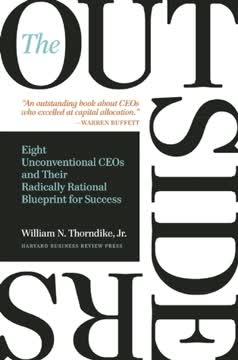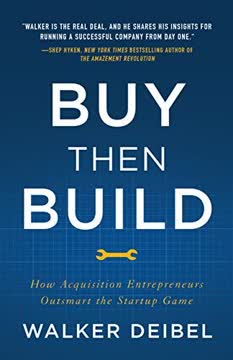Key Takeaways
1. Acquisition Entrepreneurship: A Better Path to Business Ownership
Startups have a little flaw: they mostly fail.
Acquisition entrepreneurship offers a compelling alternative to starting a business from scratch. By purchasing an existing company, entrepreneurs can bypass the risky startup phase and immediately step into the role of CEO with established revenue, infrastructure, and customers. This approach provides:
- Lower risk: Established businesses have a proven track record and existing cash flow
- Immediate platform: Infrastructure and systems already in place
- Faster path to profitability: Revenue from day one, rather than burning through capital
- Leverage: Ability to use bank financing to maximize return on investment
Acquisition entrepreneurs can focus on growing and improving an existing business, rather than building everything from the ground up. This model combines the best aspects of entrepreneurship and investing, allowing for both operational control and financial returns.
2. The $10 Trillion Opportunity in Baby Boomer Business Transitions
The boomers are already selling off their established, successful small businesses at record rates.
A massive wealth transfer is underway as baby boomer business owners retire. This demographic shift creates an unprecedented opportunity for acquisition entrepreneurs:
- 12 million businesses owned by baby boomers (43% of all small businesses)
- Estimated $10 trillion in business value changing hands
- Increasing supply of available businesses likely to create a buyer's market
Key factors driving this opportunity:
- Aging population: 77 million boomers retiring between 2013 and 2029
- Lack of succession plans: Many owners don't have children interested in taking over
- Desire for liquidity: Owners looking to cash out for retirement
This wave of transitions provides a unique chance for the next generation of entrepreneurs to acquire established, successful businesses at potentially favorable valuations.
3. Engineering Wealth: Understanding Business as an Investment Vehicle
If you change the way you look at things, the things you look at change.
Business ownership as wealth-building tool: Acquiring and operating a business can be one of the most effective ways to build personal wealth. Key considerations:
- Return on Investment (ROI): Calculate potential returns based on purchase price and earnings
- Margin of Safety: Look for businesses with intrinsic value greater than purchase price
- Upside Potential: Identify opportunities for growth and improvement
Financial metrics to analyze:
- Seller's Discretionary Earnings (SDE): Total pretax cash flow benefit to the owner
- Multiple: Typically 2-4x SDE for small businesses, varies by industry and growth
- Working Capital: Understand cash flow cycles and capital requirements
Leverage bank financing to maximize returns:
- SBA loans can provide up to 90% of purchase price
- Potential for >100% annual ROI on invested capital
- Balance risk and return when determining optimal leverage
4. Defining Your Acquisition Target: Opportunity Profiles and Target Statements
You absolutely do not need to be in a great industry to produce sustained great results.
Develop a clear acquisition strategy by defining your ideal target company. Consider these opportunity profiles:
- Eternally Profitable: Stable businesses in mature markets with consistent cash flow
- Turnaround: Underperforming companies that can benefit from operational improvements
- High Growth: Rapidly expanding businesses with strong market potential
- Platform: Companies that align with your specific skills and growth strategy
Create a target statement that includes:
- Industry type (product, distribution, or service)
- Growth opportunity you can execute
- Size range (defined by SDE, not revenue)
- Any geographic or other limitations
Example: "I am looking for a distribution company with strong sales but needing operational excellence, generating $300,000 to $400,000 in SDE, in the Chicago area."
5. The CEO Mindset: Aligning Attitude, Aptitude, and Action
Having a growth mindset is often regarded as the number one predictor of entrepreneurial success.
Develop the right mindset for acquisition entrepreneurship by aligning three key areas:
-
Attitude:
- Cultivate a growth mindset (belief in ability to learn and improve)
- Embrace challenges and persist through setbacks
- Learn from criticism and find inspiration in others' success
-
Aptitude:
- Assess your strengths and weaknesses
- Key competencies: strategic thinking, interpersonal skills, financial acumen
- Identify areas for improvement and seek complementary skills
-
Action:
- Define your ideal daily activities and work style
- Determine whether you're more focused on revenue generation or operational execution
- Align acquisition targets with your preferred role and strengths
Use tools like SWOT analysis and personality assessments to gain self-awareness. Seek businesses where your skills and interests align with the growth opportunity.
6. Navigating the Search Process: Brokers, Listings, and Deal Flow
Because that's where the money is.
Generate deal flow by building relationships with key players in the business-for-sale market:
-
Business Brokers and M&A Advisors:
- Meet with multiple intermediaries in your area
- Present yourself as a serious, capable buyer
- Clearly communicate your target statement
- Get on their email lists for new listings
-
Online Listings:
- Use as research tool, not primary source
- Understand limitations of publicly listed businesses
- Look for trends and comparisons
-
Direct Outreach:
- Contact owners of businesses you're interested in
- Network within target industries
- Leverage industry associations and events
Remember: The best deals often never make it to public listings. Focus on building relationships and getting "upstream" in the deal flow process.
7. Valuation and Financial Analysis: Buying for the Future, Paying for the Past
Buy for the Future, Pay for the Past
Understand the financials to determine a fair price and identify growth opportunities:
Key Financial Statements:
- Balance Sheet: Assets, liabilities, and owner's equity
- Income Statement: Revenue, expenses, and profitability
- Cash Flow Statement: Sources and uses of cash
Important Metrics:
- Seller's Discretionary Earnings (SDE): True cash flow to owner
- EBITDA: Earnings before interest, taxes, depreciation, and amortization
- Working Capital: Current assets minus current liabilities
Valuation Methods:
- Multiple of SDE/EBITDA: Most common for small businesses
- Discounted Cash Flow (DCF): More complex, used for larger deals
- Asset-Based: Considers tangible and intangible assets
Perform a "stress test" to understand downside risk:
- Calculate minimum SDE needed to cover debt service and management salary
- Determine how much revenue could decline before causing financial distress
Look beyond historical performance to identify future growth potential and areas for improvement under your management.
8. Making an Offer: Letter of Intent and Negotiation Strategies
Time kills all deals.
Craft a compelling offer using a Letter of Intent (LOI) to outline key deal terms:
Essential LOI Components:
- Type of sale (asset vs. stock)
- Purchase price and structure
- Proposed closing date
- Contingencies (financing, due diligence, etc.)
- Escrow and expense details
- Confidentiality and exclusivity terms
Negotiation Strategies:
- Focus on win-win outcomes
- Understand seller's motivations beyond price
- Be prepared to walk away if terms aren't favorable
- Move quickly to maintain momentum
Consider deal structures beyond all-cash offers:
- Seller financing: Aligns interests and reduces upfront capital needs
- Earnouts: Tie portion of purchase price to future performance
- Equity rollovers: Allow seller to retain partial ownership
Remember: The LOI is non-binding but sets the framework for the final purchase agreement. Be thorough but avoid getting bogged down in minor details at this stage.
9. Due Diligence: Verifying and Understanding the Business
Results are gained by exploiting opportunities, not by solving problems.
Conduct thorough due diligence to verify information and uncover potential issues:
Key Areas of Focus:
- Financial: Verify historical performance and projections
- Legal: Review contracts, licenses, and potential liabilities
- Operational: Understand processes, systems, and key personnel
- Market: Assess competitive landscape and growth potential
Due Diligence Best Practices:
- Create a comprehensive checklist
- Involve professional advisors (accountant, lawyer)
- Look for both risks and opportunities
- Document findings and follow up on red flags
Use the due diligence period to:
- Validate assumptions from initial analysis
- Identify areas for post-acquisition improvement
- Build relationships with key employees and stakeholders
- Refine your post-closing plan
Remember: Due diligence is your best opportunity to learn the business inside and out before taking ownership. Be thorough but maintain focus on material issues.
10. Closing the Deal and Transitioning to CEO
Once you put $2 million in someone's bank account, you start to learn what's really going on.
Execute a smooth transition from buyer to CEO:
Closing Day Preparations:
- Review and approve all closing documents in advance
- Finalize inventory counts and working capital adjustments
- Coordinate with bank, lawyers, and other advisors
- Be prepared for last-minute issues or negotiations
First 90 Days as CEO:
-
Month 1 - Focus on People:
- Meet with all employees individually
- Communicate vision and address concerns
- Connect with key customers and suppliers
-
Month 2 - Learn the Business:
- Dive deep into systems and processes
- Identify areas for improvement
- Create 13-week cash flow projection
-
Month 3 - Implement Your Plan:
- Begin executing growth initiatives
- Make necessary operational changes
- Establish performance metrics and reporting
Keys to successful integration:
- Overcommunicate with employees and stakeholders
- Look for quick wins to build momentum
- Balance maintaining stability with driving positive change
- Stay focused on your long-term vision and growth strategy
Remember: The first 90 days set the tone for your leadership. Be visible, listen actively, and start building the foundation for future success.
Last updated:
FAQ
What's Buy Then Build about?
- Acquisition Entrepreneurship Focus: Buy Then Build by Walker Deibel centers on acquisition entrepreneurship, where entrepreneurs purchase existing businesses instead of starting new ones. This strategy offers immediate cash flow and established customer bases.
- Framework for Success: The book provides a comprehensive framework for navigating the acquisition process, including identifying, evaluating, and executing business deals.
- Market Opportunity: Deibel highlights the wealth transfer as baby boomers retire, presenting a unique opportunity to acquire businesses at favorable prices.
Why should I read Buy Then Build?
- Practical Guidance: The book offers actionable advice for acquiring businesses, making it a valuable resource for both novice and experienced entrepreneurs.
- Real-World Examples: Deibel shares personal experiences and case studies, providing relatable insights into acquisition entrepreneurship.
- Emerging Trend: As acquisition entrepreneurship gains popularity, the book prepares readers to capitalize on current market opportunities.
What are the key takeaways of Buy Then Build?
- Acquisition Over Startup: Buying an existing business is often more advantageous than starting a new one, due to established infrastructure and customer bases.
- Financial Metrics Importance: Understanding metrics like Seller Discretionary Earnings (SDE) is crucial for evaluating business value and potential.
- Mindset Shift: The book encourages viewing entrepreneurship as acquiring and improving existing businesses, opening new avenues for success.
What is Acquisition Entrepreneurship as defined in Buy Then Build?
- Definition: Acquisition entrepreneurship involves buying an existing business and applying entrepreneurial skills to enhance its value.
- Benefits: This approach reduces risk, provides immediate cash flow, and leverages existing infrastructure for growth.
- Market Opportunity: The aging baby boomer population creates a favorable environment for acquiring businesses.
How does Buy Then Build suggest evaluating a business for acquisition?
- Financial Performance Review: Analyzing financial statements like income and balance sheets is crucial for assessing business health.
- Seller Discretionary Earnings (SDE): Understanding SDE helps determine business value and informs purchase price.
- Market Position and Growth Potential: Evaluating market position and growth potential is essential for identifying operational improvements.
What are the common pitfalls in acquisition entrepreneurship mentioned in Buy Then Build?
- Lack of Preparation: Failing to prepare adequately can hinder the acquisition process; having a clear target statement is crucial.
- Overlooking Due Diligence: Skipping thorough due diligence can lead to costly mistakes; verifying financial and operational health is vital.
- Ignoring Seller's Perspective: Not considering the seller's motivations can hinder negotiations; building rapport is essential.
What is the significance of Seller Discretionary Earnings (SDE) in Buy Then Build?
- Key Valuation Metric: SDE is critical for evaluating a business's financial performance and determining its value.
- Impact on Purchase Price: The purchase price is often based on a multiple of SDE, aiding in informed offers and negotiations.
- Comparison to Revenue: Focusing on SDE provides a clearer picture of profitability and cash-generating ability.
What strategies does Buy Then Build recommend for finding acquisition opportunities?
- Networking with Brokers: Building relationships with brokers helps tap into deal flow before public listings.
- Direct Outreach: Reaching out to business owners directly can uncover hidden opportunities.
- Utilizing Online Resources: Online listings are valuable for initial research, but should not be solely relied upon.
What are the financial considerations when acquiring a business as per Buy Then Build?
- Leverage and Financing: Using leverage can enhance return on investment, but associated risks must be managed.
- Understanding Cash Flow: Evaluating cash flow is crucial for determining debt serviceability and returns.
- Budgeting for Expenses: Accounting for all potential expenses, including closing costs, is essential for successful transactions.
What mindset shifts does Buy Then Build advocate for aspiring entrepreneurs?
- From Startup to Acquisition: Shifting focus from starting new businesses to acquiring existing ones opens new opportunities.
- Embracing a Growth Mindset: Viewing challenges as learning opportunities is crucial for navigating acquisition complexities.
- Commitment to Action: Proactive action and urgency in the acquisition process are necessary for seizing opportunities.
What is the role of due diligence in the acquisition process according to Buy Then Build?
- Verification of Information: Due diligence involves verifying financial, legal, and operational information for accuracy.
- Identifying Risks: It helps uncover potential risks or liabilities, crucial for informed decision-making.
- Comprehensive Understanding: Due diligence covers legal, financial, and operational aspects for a thorough business assessment.
What are the best quotes from Buy Then Build and what do they mean?
- “To hell with circumstances; I create opportunities.”: This quote by Bruce Lee emphasizes a proactive mindset in entrepreneurship, encouraging control over circumstances.
- “Results are gained by exploiting opportunities, not by solving problems.”: Focus on growth and potential rather than merely addressing issues for successful entrepreneurship.
- “The difference between ordinary and extraordinary is that little extra.”: Small, additional efforts can lead to significant outcomes in business and life.
Review Summary
Buy Then Build receives mostly positive reviews for its comprehensive guide on acquiring small businesses. Readers appreciate the practical advice, frameworks, and insights into the acquisition process. Many find it eye-opening and helpful for those considering entrepreneurship through acquisition. However, some criticize the book for overselling opportunities, lacking real-world examples, and containing typos. Critics also note that it's US-centric and doesn't deeply cover topics like valuation. Overall, reviewers consider it a valuable resource for understanding the potential of buying existing businesses.
Similar Books










Download PDF
Download EPUB
.epub digital book format is ideal for reading ebooks on phones, tablets, and e-readers.




